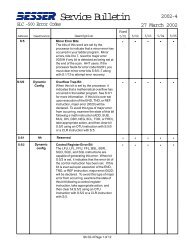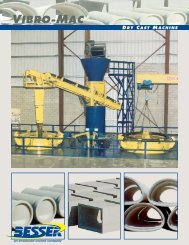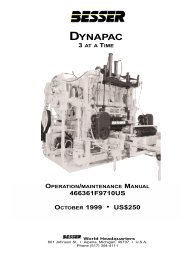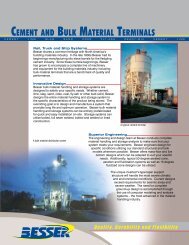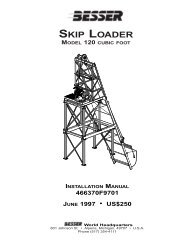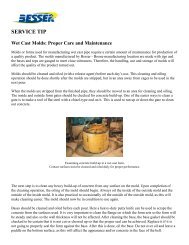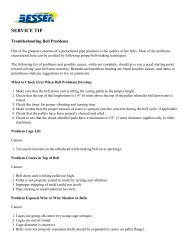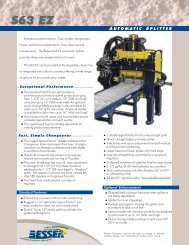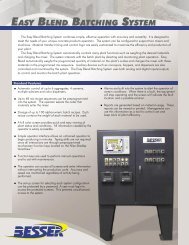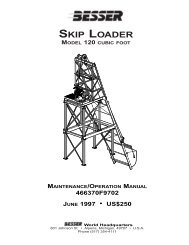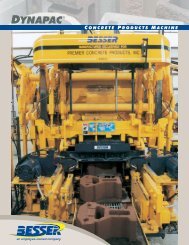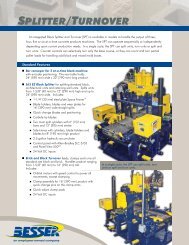Safety Bulletin - Besser Company
Safety Bulletin - Besser Company
Safety Bulletin - Besser Company
Create successful ePaper yourself
Turn your PDF publications into a flip-book with our unique Google optimized e-Paper software.
Corporate <strong>Safety</strong> Programs:<br />
If You Can’t Afford <strong>Safety</strong>, You Can’t Afford To Be In Business<br />
Does my company<br />
need a corporate safety program?<br />
As a plant owner or supervisor/<br />
manager, you are no doubt<br />
extremely busy with the day-to-day<br />
pressures of running a successful<br />
business. How can you also devote time<br />
to ensure a safe work environment…<br />
because as an employer you must. It is<br />
a requirement that you protect workers<br />
from harm. But, equally important, it is<br />
to your benefit to institute a complete<br />
safety and risk control program in<br />
your facility.<br />
FACT – 98% of all accidents and<br />
injuries are caused by unsafe working<br />
conditions, unsafe acts of personnel<br />
or a combination of both.<br />
FACT – Employers that demonstrate<br />
to employees that they really do care<br />
about safety are likely to have fewer<br />
workplace accidents.<br />
I carry worker’s compensation<br />
insurance in case of an accident –<br />
isn’t that enough?<br />
The cost of accidents fall into two<br />
categories:<br />
� Insured Costs – Worker’s<br />
Compensation will cover:<br />
• Medical costs<br />
• Compensation costs<br />
� Uninsured Costs – Not covered by<br />
Worker’s Compensation:<br />
• Lost production time of injured<br />
worker getting first aid or medical<br />
attention<br />
• Costs of time spent investigating<br />
and reporting injuries, handling<br />
injured worker<br />
• Costs of hiring and training<br />
replacements for injured workers<br />
by Amy E. Essex<br />
<strong>Besser</strong> <strong>Company</strong> Tax and Risk Manager<br />
• Interruptions and delays caused by<br />
accidents<br />
• Damage to machines and materials<br />
caused by accidents<br />
• Other indirect inefficiencies and<br />
hindrances<br />
It has been estimated that uninsured<br />
costs are usually several times the insured<br />
costs. The amount paid for worker’s<br />
compensation insurance is only a small<br />
part of the total cost of accidents, even<br />
though this is the most obvious direct<br />
outlay of money. Preventing accidents<br />
pays doubly by reducing worker’s<br />
compensation premiums and by reducing<br />
uninsured costs as well.<br />
Even if insurance paid all costs,<br />
you still have a responsibility to keep<br />
employees safe from harm. If a worker<br />
suffers a fatal injury in your plant,<br />
all the insurance in the world won’t<br />
bring him/her back. An effective safety<br />
and risk control program includes<br />
safety and injury prevention activities<br />
as well as post-accident loss control<br />
measures. Every effort should be made<br />
to identify and eliminate physical<br />
hazards and educate employees as to<br />
the most cautious and efficient method<br />
of performing required tasks. If an<br />
injury does occur, despite safety and<br />
injury prevention measures, the risk<br />
control program must have appropriate<br />
post-incident follow-up activities<br />
in place to minimize the severity of<br />
the incident.<br />
Whose responsibility is safety?<br />
Each employee in your facility is<br />
responsible for certain aspects of safety.<br />
<strong>Safety</strong> responsibilities should be placed<br />
and accepted as follows:<br />
� Management:<br />
• State and enforce a policy<br />
on safety<br />
• Provide a safe workplace<br />
• Prescribe safe work practices and<br />
procedures<br />
• Provide adequate training and<br />
competent supervision<br />
• Designate responsibility and<br />
delegate authority to supervisors<br />
� Supervisors:<br />
• Train personnel in proper and safe<br />
work practices<br />
• See that proper practices are<br />
followed<br />
• Investigate all injuries for causes<br />
• Take corrective action when unsafe<br />
conditions or work methods are<br />
observed<br />
• Maintain safe equipment, tools,<br />
environment<br />
� Employees:<br />
• Observe prescribed work practices<br />
• Report to supervisor any hazards<br />
that exist<br />
• Report all injuries immediately<br />
• Use protective devices and<br />
safety equipment<br />
What are the elements<br />
of a complete corporate safety<br />
and risk control program?<br />
� A <strong>Company</strong> <strong>Safety</strong> Policy<br />
� A Safe Work Environment<br />
• Eliminate Mechanical and Physical<br />
Hazards<br />
• Keep guards on machinery<br />
• Maintain good housekeeping<br />
• Promote safe materials handling<br />
methods<br />
• Properly maintain tools and<br />
equipment<br />
• Ground and control electricity<br />
FACT – 98% of all accidents and injuries are caused<br />
by unsafe working conditions, unsafe acts of personnel<br />
or a combination of both.<br />
FACT – Employers that demonstrate to employees that they really<br />
do care about safety<br />
are likely to have fewer workplace accidents.<br />
11



